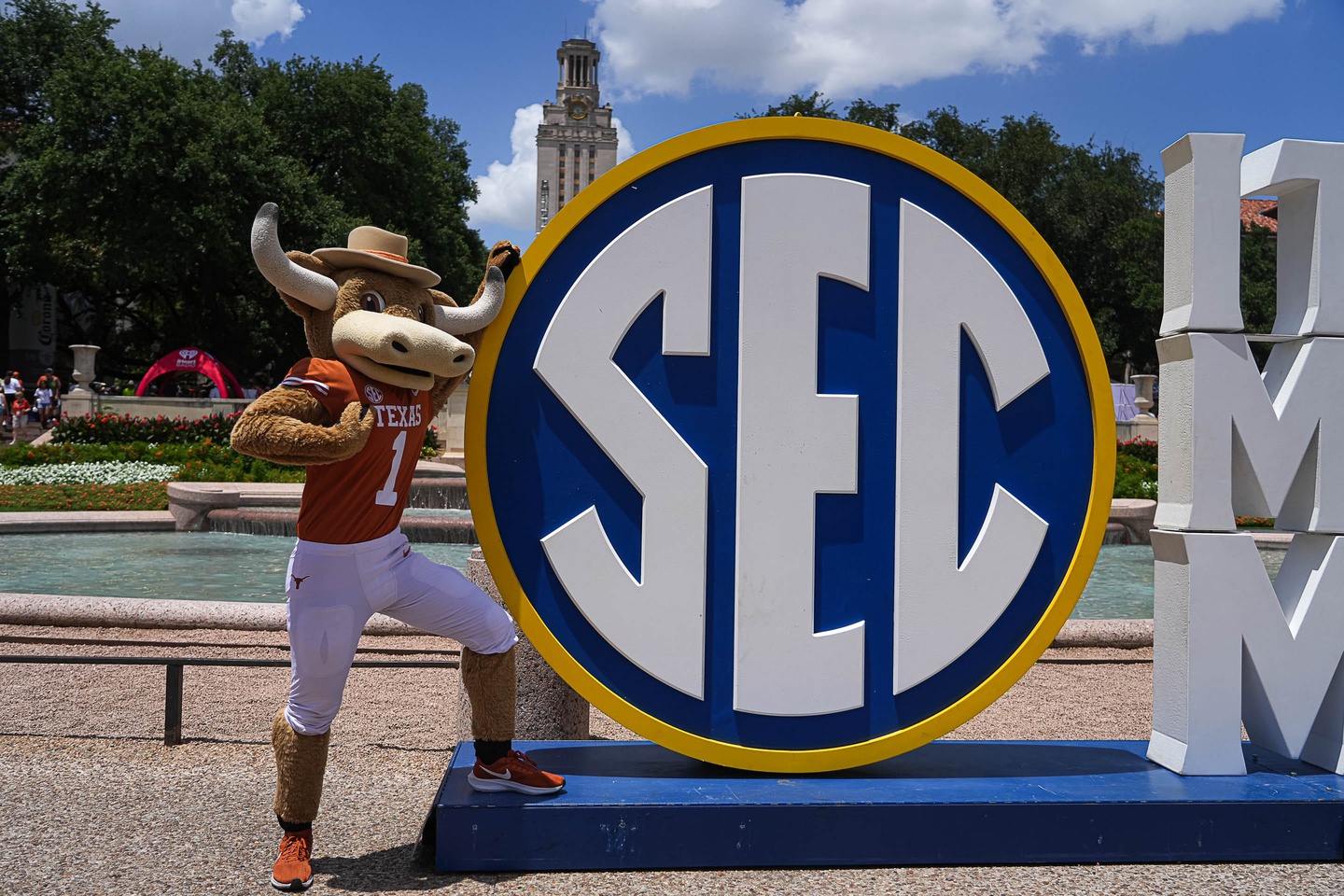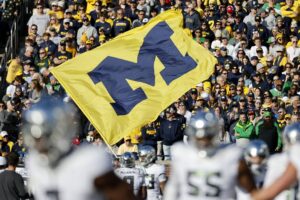July 1st, 2024* was a major day in college athletics. The conference realignment monster rears its ugly head once again and college athletics has been turned on its side. During this, every power conference is affected, and between 2024 and 2025 at least four of the Group of Five conferences will be as well. The one constant of conference affiliation in the 21st century is that membership has not been constant. We now enter the era of the “super conference”. When the dust settles, the four power conferences will each have 16 or more members.
It’s worth noting that this isn’t the first time we’re seeing 16-team conferences. The Western Athletic Conference tried it. They utilized a weird pod system. It worked out so well, that half of the membership left to create the Mountain West Conference. Unlike with the WAC, conferences do not need to keep divisions anymore, so it allows for membership flexibility. The increased financial compensation should also help history from repeating. Let’s look at the conferences and how this round of conference realignment is affecting each.
SEC
The one that started it all. In 2021, Texas and Oklahoma of the Big 12 reached out to the SEC about potential membership. This began a chain of events that changed the membership in every FBS conference. Since the Big 12 has a grant of rights, these teams negotiated with the conference to leave after the 2023-24 year. In the meantime, it was business as usual for the SEC. The conference negotiated a new media deal exclusively with ESPN, ending the long tradition of the SEC on CBS. With Texas and Oklahoma joining, the SEC now has 16 members and enters “super conference” territory
PAC-12
The PAC-12 is dead. Long live the PAC-12. Conference realignment saved its most brutal fate for the PAC-12 After losing 10 of its 12 members, there isn’t much left other than Oregon State and Washington State. The destruction of the PAC-12 started long before the announced departure of USC and UCLA. There were years of missteps, bad decisions, and a metric ton of arrogance that helped create the current-day mess. The clock began ticking when USC and UCLA shocked the college football world with the move to the Big Ten. The conference needed a new media deal and with two of its largest brands leaving, this hurt the value and prospects of the conference.
When PAC-12 commissioner George Kliavkoff presented an iceberg of a streaming-only option from Apple as the lone offer, that was the final straw as Washington and Oregon were willing to take partial shares from the Big Ten just to get on solid land. Colorado was already planning on leaving at this point and returning to the Big 12. Seeing the ship was taking on way too much water, the other Four Corner schools Arizona, Arizona State, and Utah also jumped ship to the Big 12. This left OSU, Wazzu, Cal, and Stanford as the final members. The ACC threw Cal and Stanford a discounted payout life preserver, leaving OSU and Wazzu as the last two on the PAC-12’s version of the Titanic.
The conference has two years to get to the minimum number of members to continue operating. In the meantime, the two will be temporary affiliate members of the West Coast Conference for the majority of their non-football sports and have secured a scheduling arrangement with the Mountain West that is outlined in the Mountain West section below.
Big Ten
Not to be outdone by the SEC, the Big Ten made a big splash by inviting USC and UCLA into the fold to join in 2024. This is the first expansion for the conference since bringing in Maryland and Rutgers in a pure television market move. This time, brand value was a big driver along with the southern California market. While the SEC increased its footprint slightly, the Big Ten decided to go national behind the leadership of league commissioner Kevin Warren. Warren pushed to create a western front in the conference but did not see it through as he took a job with the Chicago Bears. Tony Pertitti took over and did not have the same Western appetite as Warren. The conference’s media partners lacked that appetite too. It was no secret that schools like Oregon, Washington, and Utah pined for the chance to join the Big Ten.
Things stayed quiet until the PAC-12 members saw a streaming-only media offer from Apple. Once Oregon and Washington received it, the wheels started moving again. Oregon and Washington were desperate enough that both agreed to a reduced payout to join. This gives the Big Ten 18 members. When the next media deal is negotiated, these additions will receive a full share. Once Oregon and Washington made known their intention to go to the Big Ten in 2024, the rest of the PAC-12 fell apart.
ACC
Conference realignment has been holding its breath with the ACC. With this conference, it has the potential to be a tale of two acts. On the one hand, the conference took advantage of the PAC-12’s demise by grabbing Cal and Stanford at a discounted price. On the other hand, the ACC has a growing problem due to its media deal and grant of rights. With the Big Ten and SEC dwarfing the ACC in payout, this has caused unrest with the larger ACC schools like Florida State and Clemson. Each has filed a lawsuit to try and get out from under the grant of rights.
SMU from the American Athletic Conference lobbied heavily to join the ACC. SMU went as far as to offer to forego its media payout completely for seven years, raising the money privately to offset the loss. The move to invite Cal, Stanford, and SMU was not unanimous. Multiple schools, including the aforementioned Florida State and Clemson, voted against it. However, the ACC member schools know that if their membership falls below 15 members, it opens the door for ESPN to renegotiate the media deal and not in the way the ACC members would like. This move pushes them to 18 members. If the conference falls apart, these schools could rebuild with Group of Five schools or try to find homes with the remaining power conferences.
Big 12
The Big 12 had four members join the conference last year: Independent BYU and American members Cincinnati, Houston, and UCF. This move was in preparation for the big move of Texas and Oklahoma to the SEC in 2024. After a slightly awkward, but peaceful final season, the day has finally arrived and the two biggest brands of the Big 12 are moving on. The Big 12 was ready to stay as a 12-team conference, but commissioner Brett Yormark yearned for more. He took the initiative and negotiated a new media deal early with ESPN and Fox to begin in 2025. The ESPN portion has a pro-rate clause for power conference schools in case of expansion. The conference increased its per-member payout even with the loss of Texas and Oklahoma.
He explored several other options, both in the box and out, to create revenue. Part of his strategy is to expand from 12 members. His primary target was the Four Corner schools of Arizona, Arizona State, Colorado, and Utah. All four were still in the PAC-12 and weren’t going to leave at this point. Yormark started considering UConn for all sports and Gonzaga as a non-football member.
When the PAC-12 kept delaying presenting a new media deal, Colorado grew impatient and began to talk to its former home, the Big 12. By the time the streaming deal was presented, Colorado had one foot out the door. Arizona then began to waver. It too started talking to the Big 12 and was ready to make the jump. Arizona State president Michael Crow stood in its way because the state Board of Regents wanted the schools to stay together and Crow enjoyed being a big fish in the PAC-12 pond. He relented when he could see the conference could not be saved. Utah was the last to make the jump. With all of the Four Corner schools secured, the Big 12 has settled on 16 members for now.
American Athletic Conference
The Group of Five conferences has also been affected by conference realignment. We already mentioned SMU leaving the American and joining the ACC. The AAC used this as an opportunity to make a move it has long wanted to do: Invite Army West Point as a football-only member. When the AAC was in flux after the split of the Big East, it arranged for the Naval Academy to join in 2015 and tried to bring Army in as well. Army, remembering its less-than-stellar time in Conference USA, declined, which also helped the Air Force Academy decide to stay in the Mountain West. Army now sees the benefit of conference affiliation and will join this year. The conference made accommodations to keep the Army/Navy game after the conference championship game. This will keep the American at 14 football-playing members.
Conference USA
Another Group of Five in conference realignment flux is Conference USA. After being gutted going into the 2023 season with the American poaching Charlotte, Florida Atlantic, North Texas, Alabama-Birmingham, Rice, and Texas-San Antonio, the conference went into survival mode. It brought in independent schools, New Mexico State and Liberty, and FCS call-ups Sam Houston State and Jacksonville State. This year, Kennesaw State makes the move up from the FCS ranks. Next year, Delaware and Missouri State will move up, giving Conference USA 12 members.
Mountain West
The Mountain West doesn’t have any membership changes as of yet but has arranged for a football scheduling agreement with PAC-12 holdovers Oregon State and Washington State. Each member of the Mountain West will play the two schools. It will not count as a conference game and the two are not eligible for a conference championship, but it will help fill the schedule and bring in some extra money to the conference. WSU will also become an affiliate member in a couple of other sports. There is a possibility that the MWC and PAC-12 have a merger or membership change between the two.
Mid-American Conference
Lastly, the MAC, the most stable of the FBS conferences, is not immune from this round of conference realignment. The conference will grow to 13 members with UMass’s addition as an all-sport member in 2025. UMass was a football-only member of the MAC from 2012-2016. The MAC executed a provision in UMass’ membership contract that they needed to join the conference for all sports or leave. The school chose to leave. After eight years as a floundering FBS independent, the Minutemen decided to rejoin the MAC to give the conference 13 members. The conference could look at FBS independent UConn, Conference USA member Western Kentucky or Middle Tennessee, or an FCS call-up as a potential 14th member. In the case of WKU and MTSU, both previously explored joining the MAC.
Welcome to the 2024-25 sports year!
*Due to legal reasons, the departing PAC-12 schools officially join their new conferences on August 2nd, but the athletic year begins on July 1st.







